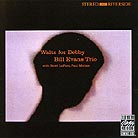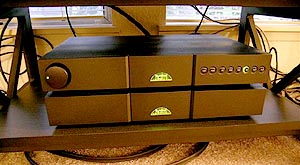 |
|||||||||||||||||
| If you could drag yourself away from the rapture of Avalon -- not easy to do with this Naim gear -- and force yourself to focus on the sound, you'd notice really good soundstage depth but width that was limited to the outer edge of the speakers. If you concentrated further, you'd probably notice that the imaging was precise and very solid. And if you concentrated further still, you'd notice that the image size was - well, life-size. The tone produced sounds very good, and I don't mean that in the normal HiFi sense. It sounds more like the tone I hear when friends are in my place playing acoustic guitars than the usual music playing through a stereo rig. |
|||||||||||||||||
| I cued up Balalaika Favorites next [Mercury Living Presence 432 000-2]. The title of this disc derives from the Russian balalaika, a big (and I mean big!) guitar-like instrument with three strings. This is the first-ever American recording made inside the Soviet Union and the results are stupendous. Russian folk music is full of strings, percussion, dramatic swells of sound, then soft, almost muted touches. The dynamics and flow of the music is inspiring and was wonderfully portrayed through the Naim 112/150, pulling back and receding like ocean waves, then swelling up and crashing down with intensity. One thing I did notice here? The Naim combo didn't retrieve that last iota of low-level detail. On Avalon, this actually made the music sound more realistic and less HiFi-ish - but on Balalaika, it took away a smidgen of sparkle and life. |
|||||||||||||||||
 |
|||||||||||||||||
I really enjoy listening to Gillian Welch's and David Rawlings' music. They achieve a soulful and mournful atmosphere that just soothes my spirit. If you want to hear great kick drum, cue up the album Soul Journey [Acony ACNY-0305] and play "Look at Miss Ohio" and observe the drum cut through the mix to give the tune a powerful forward momentum. Take note of the electric bass line and how it compliments that kick drum; how Gillian singing "I want to do right, but not right now" is so sadly right. Listening with Naim in the system allows the message in the music to come straight to the fore. Put differently, the Naim 112/150 always puts the music first, with the sound (and it's good) always the servant, never the master. Communication of the artist's intent is evident and powerful. When listening through the Naim gear, I think about the meaning of lyrics, the beauty of string tone, rhythm, melody and the emotional impact. |
|||||||||||||||||
 |
|||||||||||||||||
One of my favorite jazz recordings is the Bill Evans Trio Waltz for Debby [Analogue Productions CAPJ 009] recorded live at The Village Vanguard in New York City on June 25, 1961. Bill Evans on piano, Scott LaFaro on bass and Paul Motian on drums perform for an appreciative crowd instead of a studio microphone. A terrific performance with an intimate atmosphere results. On the Naim 112/150, Scott's bass line is terrifically rhythmic and highly virtuous, with all kinds of amazing high-speed bass runs. You enjoy all the micro-dynamics of the individual accents in Bill's piano and Scott's bass playing. The sound of the cymbals is extraordinary, with just the right amount of metallic shimmer and sparkle. The tinkle of glasses, the chit-chat of voices, the joyous laughter and all the other little sonic cues of a live venue make it feel as though you were there. Waiter, bring me a glass of Pinot, please! |
|||||||||||||||||
 |
|||||||||||||||||
|
Having listened to the Naim 112/150 to excellent effect with the Meridian 508.20 CD player as digital source, I decided to add the Audio Logic 2400 parallel-processing vacuum-tube DAC ($5000) to the signal chain. Adding the big valve DAC for signal processing duties raised the level of music reproduction to a whole 'nuther level. On the superb Schindler's List soundtrack [MCA MCAD 10969], a room-filling acoustic emerged, complimented by orchestral and vocal tone that was simply stunning. The soundstage revealed layers of depth, and the Harbeth Monitor 30s performed their disappearing trick as soundstage width now filled the room beyond the speakers' sidewalls. The ambience of the soundspace had a very natural, living and breathing quality to it, but didn't give you that big billowy and airy sound space which some listeners crave (and which is probably not realistic compared to the live experience). |
|||||||||||||||||
 |
|||||||||||||||||
|
|
|||||||||||||||||
| After concluding the review and gathering my notes, TAS-meister Stephæn Harrell and his fistful of discs stopped by for a visit. I hadn't yet shared my perceptions and was curious for his reactions. With a sudden head cold, I suffered that 'head in a barrel' thing and wasn't fully on-line again. Stephæn listened attentively and played disc after disc. "So what do you think, Stephæn?" He sat in thought for a few moments and then opined, "It's like a good frock." Confused, I doubled up, "A good frock?" "No, no, a good duck!" Stephæn corrected me. Still confused, I retorted with a blank stare. Sensing my confusion, he explained "You know, it's like a good f#&k - soft, warm and propulsive." "Oh yes, yes, that's it exactly." I lit up. In three words, Stephaen had nailed the Naim: Soft, warm and propulsive. "This could get addictive," said he. "Indeed," said I, happy as a rubber duck. |
|||||||||||||||||
 |
|||||||||||||||||
|
In summing up, the Naim 112/150 is slightly warm and a sounds a touch soft. It also imbues music with unparalleled propulsive forward momentum and rhythmic drive. The rhythm and melody always make sense. The Naim gear is unfailingly engaging and always gets across the musical message with emotional wallop. It extracts this message from any quality recording, an important consideration for music lovers. While high-quality recordings sound very good, poor recordings remain listenable and musically engaging. If you're in audio burn-out hell, the Naim combo could be the perfect musical antidote. |
|||||||||||||||||
| I worry that HiFi guys into sound per se won't get the Naim gear. They may view my picayune sonic criticisms as swinging the teeter-totter of attributes away from Naim. On the other hand, I am completely sure music lovers and people who play musical instruments will get it. The Naim duo's musical aspects are so powerful that they will slam-dunk that teeter-totter onto the ground and toss off any minor sonic nits I may have picked. Naim is HiFi gear designed for grown ups who put music first. In fact, if my musician friend John April -- a fine guitar player not into audio -- wanted to acquire a premium system, this Naim combo would be my first recommendation. Why? | |||||||||||||||||
 |
|||||||||||||||||
Because I know that whatever music John might choose to play, the system would deliver the artistic intent of its musical message in a completely engrossing way. And, it's refreshingly non-tweaky, clearly happy with the very inexpensive cables Chris Koster sent with it. You can just turn it on, fuhgeddaboudit and enjoy. If you fall asleep with the music, no big deal - you don't worry about setting the drapes on fire, or children and pets electrocuting themselves with tubes. The Naim just sits there in entirely demure fashion and does its thang: Make great music. |
|||||||||||||||||
 |
|||||||||||||||||
 |
|||||||||||||||||
|
Naim-USA's website
|
|||||||||||||||||
 |
|||||||||||||||||